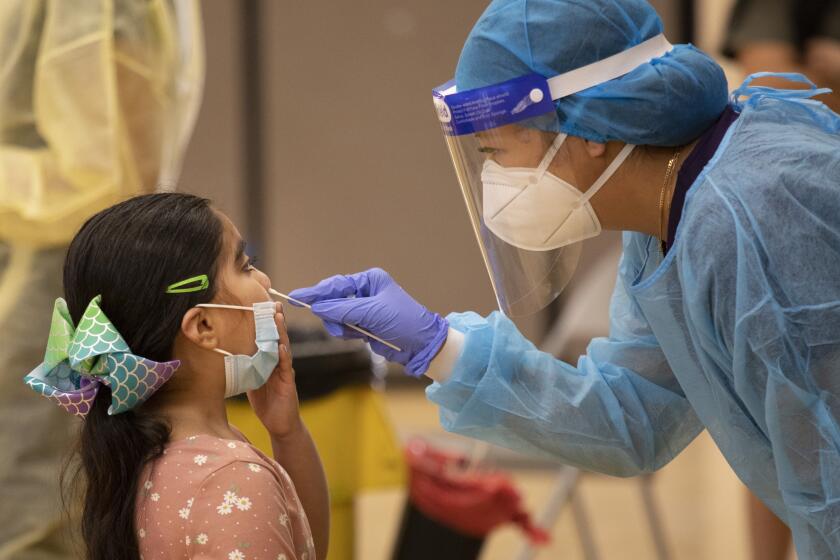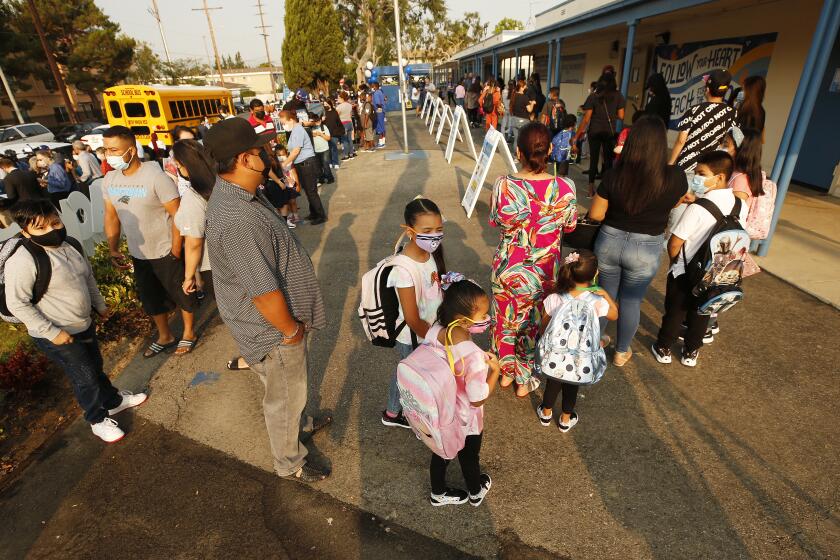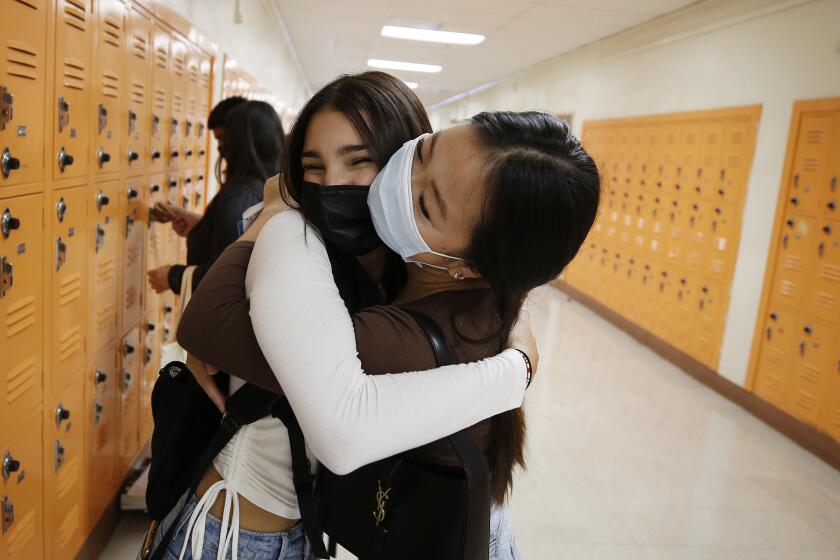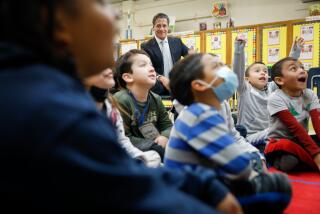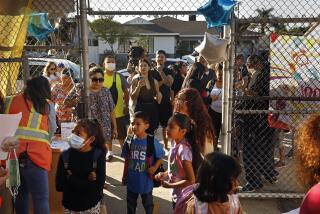LAUSD reports 3,255 student coronavirus cases in ‘baseline’ back-to-school testing

Despite the threats posed by the Delta variant, there are ways to enhance kids’ safety at school. Here’s what it will take to protect students.
- Share via
Eight in 1,000 Los Angeles Unified students tested positive for the coronavirus in the two weeks leading up to the Monday start of the academic year, according to “baseline” testing results, a rate of infection that has crept up since the close of summer school on July 23.
Because L.A. Unified is so large — with more than 450,000 students expected to attend classes in person, the number of student infections also was large, totaling 3,255 students, with an overall infection rate of 0.8%. The infection rate among the district’s staff was smaller, at 0.6%.
Officials said they remain confident that campuses are safe and the best place to be for the vast majority of students.
The district released the data after an opening Monday of both happy returns and high frustration — when the district’s student health-check system — called Daily Pass — failed, leading to long lines and missed classes. But the second day seemed to go smoothly, with the Daily Pass working largely as intended. It also helped that school administrators quickly organized workarounds for the system, opened more entrances and pressed more staff into service for checking in students.
This baseline infection data from the start of the school year will be used to evaluate how the coronavirus is affecting the nation’s second-largest school district, which is operating the largest and most ambitious school-based testing program in the nation. More than half a million children and adults are to be tested weekly on campus beginning this week.
During summer school, when about 44,000 students were tested per week, the rate of positive tests rose steadily, coinciding with the communitywide surge of the Delta variant of the coronavirus. At the start of summer school in mid-June, the infection rate was about 1 in 1,000 and that increased to about 6 in 1,000 by the close of the six-week term.
As more than 1,000 schools reopen amid rising case counts, the district’s massive coronavirus testing effort is central to keeping schools safe.
Or to put it another way, about 1 in 1,000 students tested positive for the infection at the beginning of the summer; about 1 in 100 tested positive at the end of the summer.
Given the pandemic surge, the numbers are not surprising, and while they are sobering, they should be not alarming, said Dr. Smita Malhotra, the school district’s medical director.
“I’m also a parent who has a child going to an LAUSD school who’s too young to be vaccinated,” Malhotra said. “And I understand that the rising numbers can be concerning because all we want to do is keep our children safe. But we know that in-school transmission rates can remain low if we have the mitigation measures in place.”
The district’s safety measures are such that “if you are going to send your child to school, it should be an LAUSD School,” Malhotra said.
The district released data itemized geographically by six regional districts. Infections ranged from 7 students per 1,000 in the central and east areas to 10 students per 1,000 in the northwest and south.
The baseline testing period was Aug. 2-14, but was extended at a few locations through Sunday, the day before school began.
Despite the threats posed by the Delta variant, there are ways to enhance kids’ safety at school. Here’s what it will take to protect students.
Most staff members are vaccinated — which experts say provides strong but not infallible protection against serious illness and hospitalization. A vaccine requirement for all district employees takes effect Oct. 15.
Most students are less susceptible to serious illness than, for example, older adults and those with compromised immune systems or other serious health issues. But even people with mild symptoms or no symptoms at all can pass on the illness to others.
The district’s infection rate is lower than the countywide rate of 4.4%. But the lower rate in schools does not necessarily mean that campuses are less likely to have infectious people than the community at large. The numbers could be lower because everyone was tested on campus, whereas testing in other venues may be weighted heavily with people who sought out testing because they are sick or were directly exposed to the virus.
Statewide the number of tests being conducted has risen sharply in recent weeks and test positivity has actually dipped. As of Monday, the seven-day positivity rate was 6.1%, down from 6.7% two weeks ago, state data show.
The school district’s data also showed that about 1 in 5 students failed to take a baseline test before the start of school. Those students were not to be allowed on campus, although the district tried to provide quick-response antigen tests and testing referrals. All the tests require parental permission, so a rapid fix was not available for all students.
Students across California are returning to a very different school experience. Here are answers to common questions about vaccines, testing, masks and more.
It was not immediately clear how incomplete compliance affected attendance.
The district has set up a website in which parents can check the status of active cases at their schools. Students or staff who have an infection must quarantine, typically for at least 10 days. Their close contacts must quarantine for eight to 10 days depending on the situation, as explained on a school-district information page.
In a whirlwind opening-day tour of campuses, interim Supt. Megan Reilly repeatedly emphasized that schools are a safe and proper place to be for students.
“Everyone needs to understand the many layers and how our safety protocol works,” Reilly said. “We’ve created here at Los Angeles Unified some of the safest environments. It’s a controlled environment. It’s safer in many of our schools than it is out in the public.”
She listed measures that included high-grade HVAC filters, masking indoors and outdoors, a daily health-screening system and weekly testing: “Many layers of safety are happening to keep the virus at bay and to keep our children safe.”
Several parents reported that the air conditioning was out of service in some classrooms and in at least two schools — making them question the ventilation claims. But then again, it’s hard to keep every air conditioner in every classroom working all the time on some 1,000 campuses — even when there’s more at stake than creature comforts.
On the district’s television station, Reilly on Monday tried to build confidence in the ventilation efforts, conducting an interview with two of the district’s internal environmental managers, whose checklist includes making sure the filters are clean and that systems are working.
L.A. Unified suffered a blow to confidence-building on Monday, when its Daily Pass system — which took millions of dollars and more than a year to set up — failed just as it was needed most. But what a difference a day made at a sampling of campuses across the sprawling school system.
“Yesterday was bad — really bad: 2½-hours-standing-in-the-sun bad,” Phil Connery, whose daughter is entering ninth grade at North Hollywood High School, said in an email. But one day later, “there was zero line, sufficient [personnel] in place to check in students safely — and in time for them to make their classes. There were several ‘barkers’ who were simply answering questions, directing arriving students etc.”
They arrived at 7:25 a.m., and his daughter was in by 7:26 a.m.
“As frustrated and angry as I was yesterday,” said Connery, “I’m impressed as hell with the adjustments made.... It is not sufficient to say: Today was better than yesterday. The truth is, today was excellent.”
More to Read
Sign up for Essential California
The most important California stories and recommendations in your inbox every morning.
You may occasionally receive promotional content from the Los Angeles Times.
